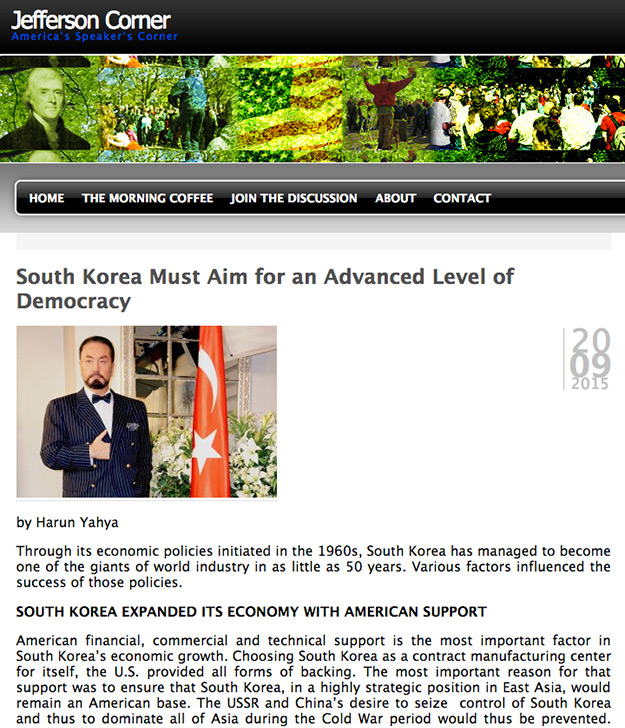
Through its economic policies initiated in the 1960s, South Korea has managed to become one of the giants of world industry in as little as 50 years. Various factors influenced the success of those policies.
SOUTH KOREA EXPANDED ITS ECONOMY WITH AMERICAN SUPPORT
American financial, commercial and technical support is the most important factor in South Korea’s economic growth. Choosing South Korea as a contract manufacturing center for itself, the U.S. provided all forms of backing. The most important reason for that support was to ensure that South Korea, in a highly strategic position in East Asia, would remain an American base. The USSR and China's desire to seize control of South Korea and thus to dominate all of Asia during the Cold War period would thus be prevented. Through a model of a wealthy and democratic South Korea, America would be winning a strong ally and bringing about the moral collapse of the communist bloc.
The country urgently needed material aid and a national development policy. In addition to material assistance from the U.S., war compensation from Japan and easy credit from international credit institutions also assisted the success of the policies implemented.
During the Vietnam War of 1963-73, the U.S. enjoyed South Korean support. In return, it continued to assist many moves towards development in South Korea.
South Korea soon succeeded to turn its assembly economy, which was initially started for the U.S., into an economy that produces and sells technological products. It competed with China in the electronics industry in particular and came to occupy a global place in the automotive, ship building and machine industries.
Another factor in the success of the policies was that South Korea adopted a Japanese-style training and working model. These policies were successfully implemented thanks to authoritarian and repressive military regimes. The positive effects on the economy of these policies were welcomed by the public, for which reason the existing authoritarian regime was little questioned.
THE EFFECT OF JAPAN ON KOREA
Throughout its history, Korea was generally governed through authoritarian and oppressive regimes closed to the outside world. From the 18th Century, the country became the scene of power struggles between Japanese and Chinese dynasties. In the 19th Century it came under the influence of the Japanese Empire, and was colonized by Japan in 1910.
With the Japanese defeat in World War II, Korea gained independence in 1945. Emerging from 35 years of Japanese occupation and a major civil war, the South Korean economy was at a very low level. Nevertheless, significant infrastructure work carried out by the Japanese still made its presence felt in the country.
The Japanese work{ discipline model that still dominates the country is the product of hundreds of years of relations between the two countries.
Average research and development expenditure in OECD countries is 2.2%, and 0.85% in Turkey, while in South Korea the figure is 3.7%, close to that of Japan. Japanese technology was copied. South Korea even surpassed the Japanese in domestic product usage / so much so that domestic products have a 70% preference rate in the national market.
NORTH-SOUTH TENSIONS AND AUTHORITARIANISM
With the Japanese withdrawal, Korea was literally split in two. The USSR controlled the North and the U.S. the South. After 1947, the tensions between the USSR-led Eastern bloc and the U.S.-led Western alliance began impacting on the whole world. Korea was also affected, and the country was officially divided in 1948. The Republic of South Korea, supported by the U.S. and the UN, was founded below the 38th parallel. The Democratic People’s Republic of North Korea, backed by the USSR and China, was established in the North.
The desire on the part of the USSR and China to annex South Korea as well led Korea into a major war. During the Korean War of 1950-1953 some 2.5 million people died. Although the war effectively ended in 1953, a ceasefire agreement between North and South was only finally achieved in 2007; not even that agreement could eliminate the state of tension and alarm between the two sides. Although South Korea appears to be a democratically governed country, it is still run under tight discipline with the continuing risk of war.
THE AGE OF COUPS THAT LASTED 26 YEARS
When South Korea moved to a 'semi-presidential system'- in 1972, it was being run by a military dictatorship. At the end of the Korean War in 1953, South Korean military leaders had no intention of handing over power to a civilian regime because of the growing instability in the devastated country and of the students establishing close contacts with North Korea. In the wake of rising protests, General Park Chung Hee seized power in a military coup in 1961. General Park was elected president 11 years later, in 1972, and continued to govern the country.
Following the assassination of General Park in 1979 another coup took place, in which General Chun Duhwan seized power. Using the communist threat as an excuse, General Duhwan first closed down the universities and then banned all political activity in the country. The protests in the town of Gwangju led to firing on civilians and hundreds died. Chun, who made frequent use of violence in his regime, became president in 1981 and remained in power until 1988.
President Chun promised democratic reforms as a result of growing protests in 1987. A multi-party system was adopted under the Constitution drawn up in 1988, and parliamentary elections were held that same year. The first local elections were held in March 1991 after 30 years. The death penalty handed down to General Chun for the Gwangju Massacre in 1996 gives an idea of the dark nature of the time. However, the penalty was not carried out, and he was pardoned by the president of that time. It is hard to speak of a long and stable democracy in South Korea, although reforms are being made to the system.
One important detail is this; GDP in South Korea, which first experienced civilian democracy in 1988, reached $266.8 billion. In 1961 the figure was just $2.1 billion.
To summarize, during the 26 years of authoritarian regimes which started after 1961 coup and continued until 1987, the country moved from a primarily agricultural economy to one based on technology and industry. National revenues rose 200-fold in 50 years. Per capita GDP which was $82 in 1961, rose to $11,380 in 1966 and $29,836 in 2010.
THE PEOPLE OF SOUTH KOREA DESERVE AN ADVANCED DEMOCRACY
For hundreds of years, the Koreans were forced to live in a societal structure closed to the outside world. The dynasties that ruled the country developed no close relations with foreign countries, either in trade or culture. Besides that, Korea was subjected to occupations by China and Japan, again countries far removed from Western democracies. Although the country was introduced to democracy as of 1945, the civil war and subsequent coups meant that the Koreans were still under the influence of authoritarian regimes.
Although South Korea has borne the name of a democratic republic after 1945, there was actually no democracy in the country until 1987. 1972, the year of the move to a semi-presidential system, brought no democracy to the country either, and the military dictatorship persisted. A new Constitution was drawn up in 1988 and the powers of the president were restricted. People of Korea first became acquainted with freedoms and democracy after the 1990s.
The objective in South Korea, with its semi-presidential system and federal administration, was to have a strong head of state. The reason for that was the continuing threat of war with North Korea and a still higher level of economic development targeted. The fact that the president has powers such as the right to appoint all 14 members of the Supreme Court, the highest court in the country, shows that the country still has an authoritarian structure.
South Korea is considered among the democratic countries of the world. However, in comparison with members of the EU, it is clear that the country still lacks an advanced level of democracy.
Another important fact is that South Korea has achieved its current economic status, not because of the semi-presidential system it implemented, but because of the discipline and industry of its people, their acceptance of an authoritarian state and U.S. aid. The form of government that the people of South Korea deserve is a true democracy, like that seen in the West, that is respectful of human rights and in which there are no limits on freedom of thought. The transition to such a democracy must take place at once.
Adnan Oktar's piece on Jefferson Corner:
http://www.jeffersoncorner.com/south-korea-must-aim-for-an-advanced-level-of-democracy/


